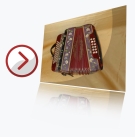
Visit the Photo Gallery

The diatonic accordion original instrument of Marche is one making part of the family of the sound locators that is “areofono ad ancia libera” in series. It is composed essentially from three parts: the case of the song, the bellows and the case of the bass. Its main characteristic is the "bitonality" that is: the ability to produce two different sounds that can change if you play opening or closing the bellows. "The spirit" of the diatonic accordion is “ancia” (the voice), it vibrates with the air emitted from the jam of the bellows that come set in action from the arms of the player. Every instrument has one consequently various tuning and a different stamp. Its fascinating history begins quite 4500 years ago, when in China appears the Sheng, instrument that for first used the principle of the “ancia libera”, that is made vibrated from one air source.
The exact date of birth of this instrument is not known whose invention, is commonly made to go back to 6 May of 1829 thanks to the work of the viennese Cyril Demian that patents the accordeon, a small instrument fortified of bellows and five keys, but much harmonious one. It narrates the legend that in 1863, a son of sharecroppers, Paul Soprani, obtained from a pilgrim, directed to the sanctuary of the Madonna di Loreto (in Marche) one harmonic that took apart in all its leaves and he recomposed it according to his criterion. That one was the first modern accordion, one instrument, whose sound became the most popular sound in the public squares of all Europe and the world.
The exemplary exposed in the Museum dedicated to Francesco Bande go back to the first of ' 900 date of their arrival in Sardinia. The first one of these instruments belonged to master Mario Bande, of Orani, father of Francesco. Most ancient of the exemplary exposed to the museum it is "La Sirena di Loreto" of 1873.